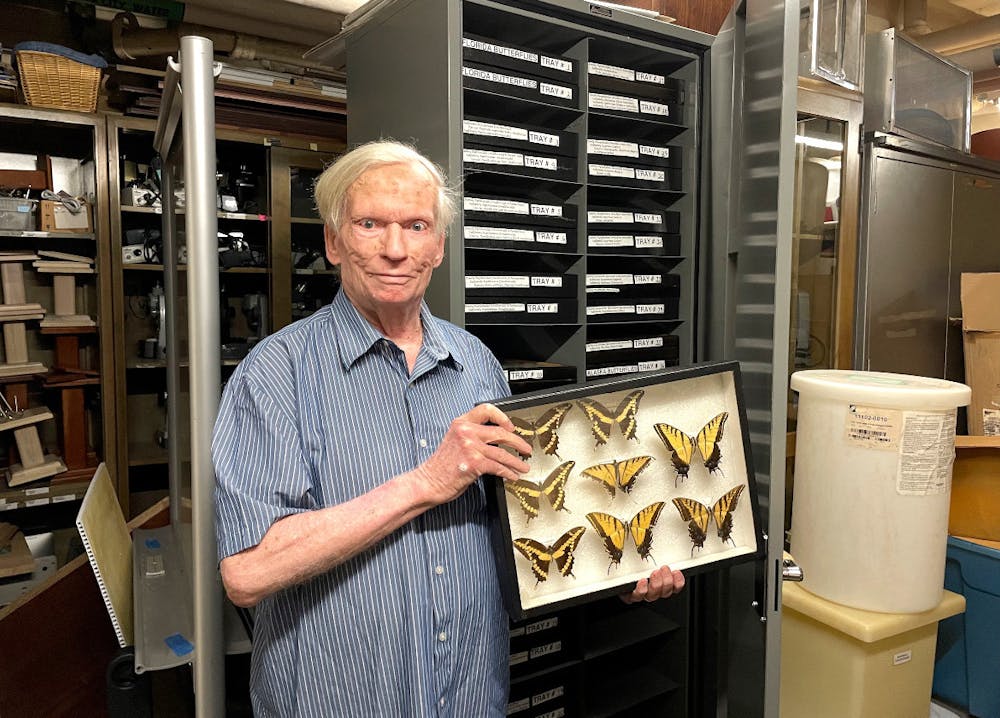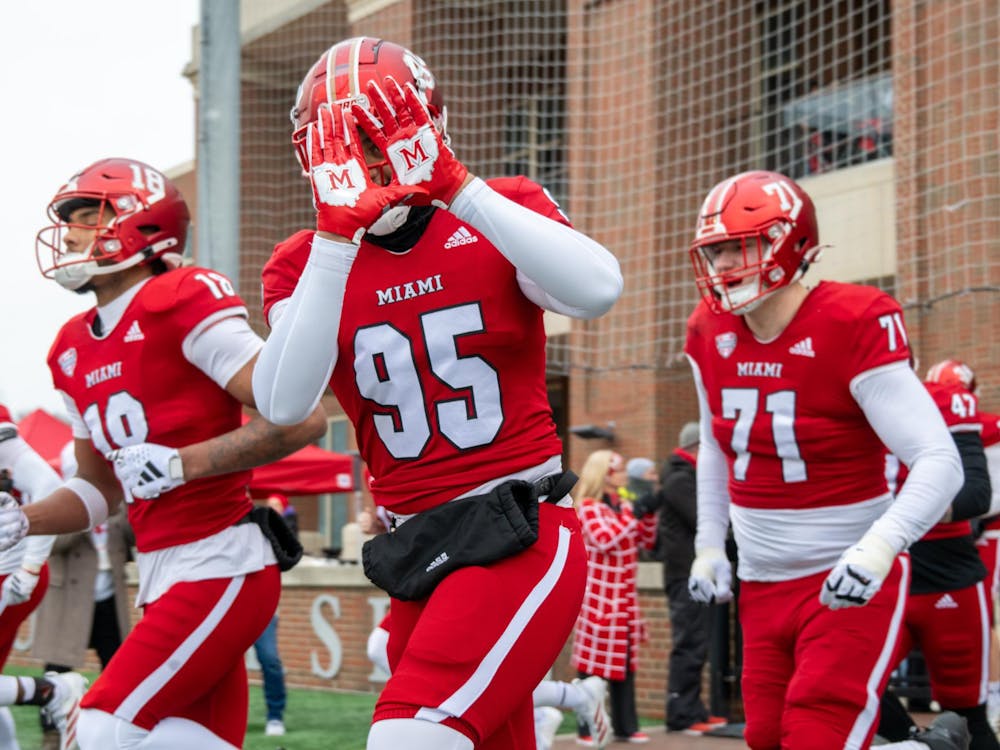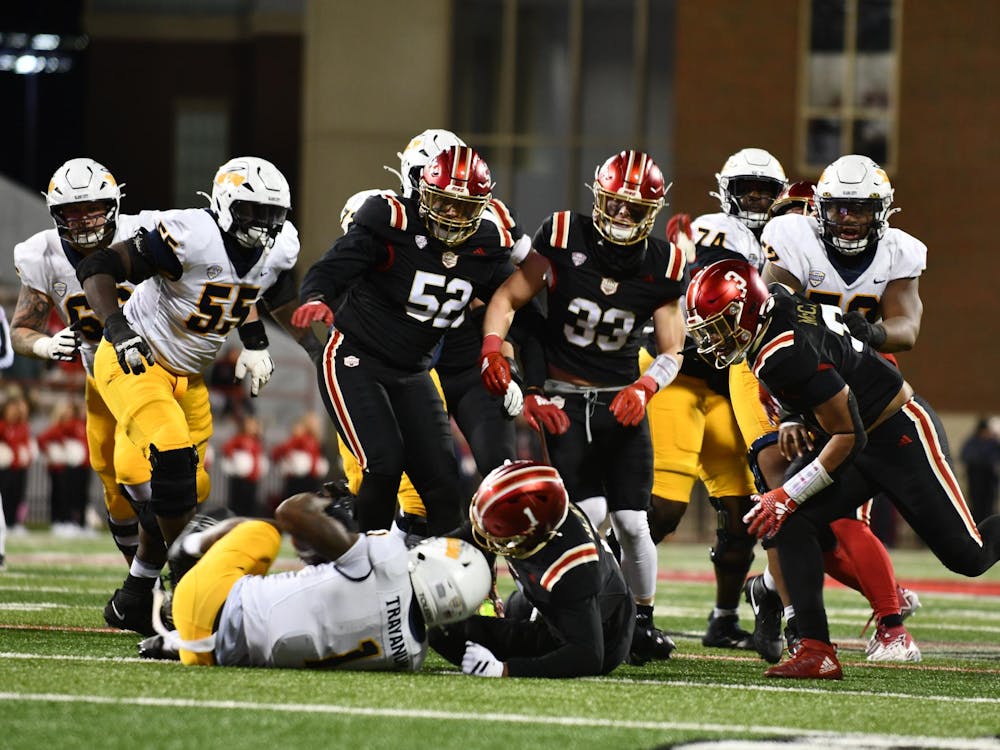In the Hefner Museum basement, below taxidermied animals from across the world, a storage room houses a giant metal box waiting to be displayed. While inconspicuous on the outside, the inside contains the lifelong work of former Miami University biology professor Jack Vaughn: a collection of meticulously labeled and organized butterflies from each of the 50 states.
Carefully pinned and arranged by state and species, the hundreds of butterflies Vaughn accumulated over the years earned him the nickname of “The Butterfly Man” and provide valuable scientific information for generations to come, particularly about genetic relationships.
“If you didn’t know anything about butterflies at all, you could see that these two species are related,” Vaughn said, pointing at two specimens lying side by side. “[By] studying the genes of different organisms, it allows us to characterize the relatedness and how it was like Darwin taught us: that different organisms came from a common origin, and then diverged over time.”
David Russell, a former colleague of Vaughn and professor in the biology department offers another perspective on the importance of Vaughn’s hobby.
“Collections [like Vaughns] are absolutely critical to give us perspective on how things have changed, not just numbers of species, but [...] some species with climate change,” Russell said. “[With butterflies] there are different body types and colors that are more appropriate in different humidities, dryness, etc, so you actually get species changing over time, and you will have no way of knowing that until you have a time series of specimens.”
But how does someone get into a relatively niche hobby such as butterfly collecting? For Vaughn, the answer lies in an appreciation for nature and a predisposition to collecting that has followed him since childhood.
“I grew up in Southern California, where there’s lots of sunshine and lots of butterflies,” Vaughn said. “I just derived a passion for nature that way, and butterflies are a part of it, but I collected everything. It wasn't just butterflies. I started with those, but I collected all kinds of insects, snakes, turtles, bird eggs - much to my mother’s chagrin.”
With samples from every state, it might be hard to pick a favorite, but Vaughn remembers one particular butterfly better than all the rest.
“I'd say my favorite one is the one from Mount Whitney,” Vaughn said, referring to the California peak which is the highest in the continental United States. “When I was 18, I was a better mountain climber. So I talked to this high school friend of mine when we graduated into going up and climbing Mount Whitney. The kinds of butterflies they have in really high mountains, they just don't have in lower elevations.”
Mountain climbing isn’t the only risky thing Vaughn has done in the name of butterfly hunting. Throughout his life, Vaughn has traversed remote Alaskan highways, Wisconsin bogs and even waded through alligator-infested swamps in Florida.
It’s time well spent, with Vaughn having personally caught around 90% of the butterflies in his collection. His collection process is careful and humane but may shock those not familiar with the processes of butterfly capture.
“I have my net, a little carrying case, paper envelopes and some killer solution to put on the butterfly to kill it,” Vaughn said. “So if I see something and catch it, I kill it with a solution, then put it in one of the little paper envelopes and write on the envelope where it was caught and when.”
Enjoy what you're reading?
Signup for our newsletter
The timeline for display can also be surprising, with butterflies waiting indefinitely before they are pinned in the shadow boxes.
“Eventually, sometimes it’s years later, I come back to those envelopes and open them up and soften the butterfly so that [it’s ready for display],” Vaughn said. “The process can take a while.”
But Vaughn didn’t spend all his time in pursuit of winged insects. In 1966, he joined Miami faculty as a professor in the biology department. Vaughn retired after the COVID-19 pandemic, but found it difficult to part with his beloved collection.
Instead of throwing away his 70+ year passion project, he was inspired to donate his butterflies where the legacy of his research could live on.
“I thought [...] I need a more approachable Smithsonian, and I knew this [Hefner] museum is here,” Vaughn said. “I've always admired it, and I admired Dr Hefner. So I thought, I'll see if they'll take it here. I'm glad they did.”
Currently, the Hefner Museum is making plans to display Vaughn’s collection, but the butterflies themselves are not out yet.
Still, interested parties looking to admire the array of insects can request to visit the butterflies or check out Vaunghn’s display book about his collection at King Library.




